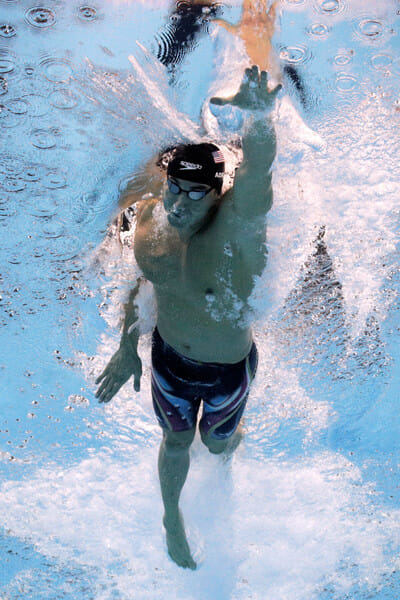In swimming, we are focused on velocity. Our objective is to swim the desired distance in the least amount of time, and thus achieving a high average velocity for the race. Our training revolves around building and sustaining speed for the duration of the race. Whenever velocity is a focus, however, power is at play. Power is the rate at which work is done (the multiple of force and velocity). In swimming, it is the amount and duration of propulsion weighed against the resistance of the water (frontal drag) that determines a swimmer’s velocity. If the swimmer’s propulsion and drag forces remain equal, the swimmer’s velocity remains constant. Any change in speed comes from a change in power, resistance, or both. Therefore, in an effort to increase sprint speed, the objective of the sprinter is to increase propulsive power without overly increasing drag. Almost any swimmer can accomplish these goals with technique development to increase stroking/kicking propulsive power (like with implementing a high-octane recovery) and to minimize the increase in frontal drag. Anyone who has trained at The Race Club knows that we believe that minimizing drag is an incredibly important component to getting faster, and we focus a great deal of our work there.
As is the case with nearly every aspect of fast swimming, though, there is a very important training component related to increasing power to go along with the very important technique component. We can (and should) increase the biochemical capacity of the muscles to produce energy and the physiological capacity to increase muscle contraction in order to increase gross swimming power. Gross power represents our possibility for top-end speed based on our given drag forces. Our frontal drag forces are determined in water by our speed, our shape (technique), position (above, below or on the surface) and the surface characteristic of our skin, swim cap and swimming suit. This quest for sprinters to increase capacity for power is similar to coaching a high jumper to improvement by working to improve his or her vertical jump. This jump training is most effective with a systematic approach, of course. We can increase speed of muscle contractions (often referred to as explosiveness) with plyometric training. We can increase the force of the contractions with weight training. We can increase muscular power output with Olympic lifting and other weighted exercises. We also, of course, increase power and overall high jump performance with lots of high jumping.
For sprinters in swimming, much of the power is similarly developed outside of the pool ((Coley Stickels podcast)), but we can also increase power with sprint training and with special equipment. The most effective way to increase swim power in the water, though, is to swim at maximum effort with added resistance. You can achieve this added resistance in a number of ways, but the most popular (and most effective) way is swimming against an external load, such as with towers, racks, pulleys, stretchchordz ((SretchChordz Video)), buckets and parachutes, which are attached to the swimmer with a belt.
When swimming against devices with a quantifiable and adjustable load, you can estimate a swimmer’s average net power within a swim, which is the power left to move the swimmer forward against the known resistance of the external load after overcoming frontal drag. To measure, simply multiply the average velocity (distance divided by time) by the force of the load exerted against the swimmer (different than the mass of the load dependent on the mechanical advantage of the device). For the purpose of this estimation, you can make up your own units as long as they are linear (like one plate, two plates, etc). To leave out the effect of the push, you should start the watch at a set point beyond the flags and finish at a set point with a known distance. You can determine a peak average net power by testing the swimmer over multiple tests increasing the resistance each time (with sufficient rest between). You can plot average net power against the resistance and find a breaking point where the swimmer’s decrease in velocity finally causes a decrease in power.
To train for power, you want to work against a load that elicits the greatest power output you’re capable of holding throughout a set. Because your peak average net power is unlikely to be sustainable, you should lighten the load by a small amount and hold a power output throughout training that is above 80% of your peak. Testing every swimmer consistently enough to keep current numbers is very time-consuming and impractical, so it is quite rare. It is important, however, to understand the testing process to quantify training loads. Knowing that we are looking for an optimal relationship between external force and speed, you can compare a swimmer’s time with and without the load to assess the difference in speed. If the swimmer’s velocity slows down by more than 25% with the load (around two seconds in a 10-meter point to point swim, depending on speed of the swimmer), the load is too heavy. We also know that if a swimmer’s times are improving over time with the same load, his gross propulsive power has increased to produce an increase in average net power, so the load can be increased in pursuit of more power yet.
As is also the case for non-resisted sprint training, the best approach for resisted sprint (power) training is to design the set to allow for repeated efforts at a very high speed and power output. This means that anything we add to the training session to increase fatigue will, in turn, decrease the effectiveness of the sprint training. For optimal results, power training is done when the swimmer is warm but not excessively fatigued and with rest adequate between repetitions for performing the set with very little regression in speed and no decrease in weight. Adequate rest is different from swimmer to swimmer, but a work to rest ratio of 1:5 is recommended as a minimum (no less rest than that). Swimmers should complete this training with the stroke and rate they plan to race a sprint with to ensure the greatest propulsive power. At The Race Club, we advocate for high octane freestyle for sprint/power free sets as a means to maximize propulsive power (through coupling), and you can expect a tutorial on high octane freestyle in our next installment from our freestyle octane series. ((Octane Intro)) It is also recommended to keep endurance training totally separate from resisted power training, as the fatigue associated with the endurance training decreases power output during the set. There’s been some investigation into determining a sustainable training zone for increasing swim power, but the general purpose of that is to determine a training zone that can be sustained throughout a set. This will likely vary by individual, but it can be monitored with considerable accuracy by the coach and swimmer. If a swimmer slows down considerably during a power set, the load can be decreased, but this is not ideal as this means the power output will be lower than it was at the beginning of the set.
The ideal volume of resisted sprint training is also variable, but assuming he starts out at a maximum effort, a swimmer can benefit as long as he maintains g a similar level of production. For some quick-twitch, stronger swimmers with very high power outputs and low capacity to recover, six reps of sprinting 15 meters might be as much good work as you can expect. For other swimmers that recover more quickly, a set of 20 repetitions might still not be exhaustive to the point of significant regression. Power training is a good example of when the specificity for the swimmer’s abilities can be extremely beneficial in determining the set. Progressive overload for this type of training is mostly self-adjusting, as gross power increases assuming the resistance is being appropriately adjusted to account for the progress, thus increasing the rate of work done. Close monitoring and consistency are very important in resisted power training, and it can be beneficial at any point in the season. To allow for appropriate recovery and balanced training, two to three sessions of resisted sprinting per week are recommended with repetitions and resistance increased as work capacity and power increase.
Understanding what power in swimming really is makes it easier to address as a swimmer goes through training. More power in the form of speed against resistance makes for a more effective training session. When you’re swimming through a power set and are tempted to back off a bit, remember that a higher power output now means a higher capacity for power later. The long rest in these sets is necessary, as your work rate is increased. Take advantage of that, and make sure your time is well spent. These sets don’t need to be pretty, but they have to be powerful!
– Brent Noble

About the Author:
Brent comes to The Race Club after spending the last seven years as a collegiate head coach. Brent brings an educational background in science into his coaching, as he studied exercise physiology and human performance in the Counsilman Center for the Science of swimming at Indiana University. His advisor was renowned swimming researcher Joel Stager, and the center is named for Gary Hall Sr’s college coach, Doc Counsilman. At IU, Brent’s study and research focused heavily on swimming power training and testing.

